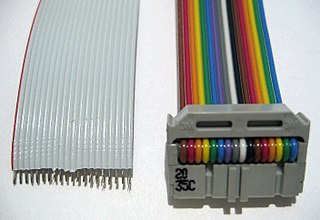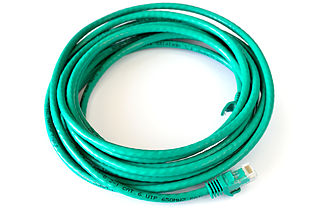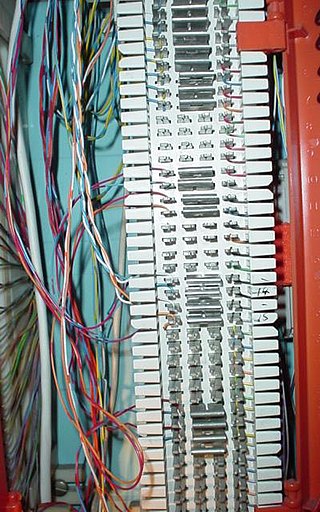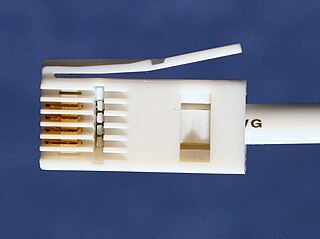
Ethernet over twisted-pair technologies use twisted-pair cables for the physical layer of an Ethernet computer network. They are a subset of all Ethernet physical layers.

Category 5 cable (Cat 5) is a twisted pair cable for computer networks. Since 2001, the variant commonly in use is the Category 5e specification (Cat 5e). The cable standard provides performance of up to 100 MHz and is suitable for most varieties of Ethernet over twisted pair up to 2.5GBASE-T but more commonly runs at 1000BASE-T speeds. Cat 5 is also used to carry other signals such as telephone and video.

Twisted pair cabling is a type of communications cable in which two conductors of a single circuit are twisted together for the purposes of improving electromagnetic compatibility. Compared to a single conductor or an untwisted balanced pair, a twisted pair reduces electromagnetic radiation from the pair and crosstalk between neighbouring pairs and improves rejection of external electromagnetic interference. It was invented by Alexander Graham Bell.

Components of an electrical circuit are electrically connected if an electric current can run between them through an electrical conductor. An electrical connector is an electromechanical device used to create an electrical connection between parts of an electrical circuit, or between different electrical circuits, thereby joining them into a larger circuit.

A ribbon cable is a cable with many conducting wires running parallel to each other on the same flat plane. As a result, the cable is wide and flat. Its name comes from its resemblance to a piece of ribbon.

In telecommunications, structured cabling is building or campus cabling infrastructure that consists of a number of standardized smaller elements called subsystems. Structured cabling components include twisted pair and optical cabling, patch panels and patch cables.

Category 6 cable (Cat 6) is a standardized twisted pair cable for Ethernet and other network physical layers that is backward compatible with the Category 5/5e and Category 3 cable standards.

A 66 block is a type of punch-down block used to connect sets of wires in a telephone system. They have been manufactured in four common configurations, A, B, E and M. A and B styles have the clip rows on 0.25" centers while E and M have the clip rows on 0.20" centers. The A blocks have 25 slotted holes on the left side for position the incoming building cable with a 50 slot fanning strip on the right side for distribution cables. They have been obsolete for many years. The B & M styles have 50 slot fanning strip on both sides. The B style is used mainly in distribution panels where several destinations need to connect to the same source. The M blocks are often used to connect a single instrument to such a distribution block. The E style has 5 columns of 10 2 clips rows and are used for transitioning from the 25 pair distribution cable to a 25 pair RJ21 style female ribbon connector.

An insulation-displacement contact (IDC), also known as insulation-piercing contact (IPC), is an electrical connector designed to be connected to the conductor(s) of an insulated cable by a connection process which forces a selectively sharpened blade or blades through the insulation, bypassing the need to strip the conductors of insulation before connecting. When properly made, the connector blade cold-welds to the conductor, making a theoretically reliable gas-tight connection.

A punch-down block is a type of electrical connection often used in telephony. It is named because the solid copper wires are "punched down" into short open-ended slots which are a type of insulation-displacement connector. These slots, usually cut crosswise across an insulating plastic bar, contain two sharp metal blades which cut through the wire's insulation as it is punched down. These blades hold the wire in position and make the electrical contact with the wire as well.
BIX is part of a telephony cross-connect system created in the 1970s by Nortel Networks. As a system, it consists of various sizes of punch-down blocks, cable distribution accessories, and a punch-down tool to terminate wires at the punch-down block. The BIX cross-connect system as a whole is certified for Category-5e. The BIX cross-connect system is primarily composed of two parts: the mounts, and the connectors.

The 1A2 Key Telephone System is a business telephone system developed and distributed by the Western Electric Company for the Bell System.

A modular connector is a type of electrical connector for cords and cables of electronic devices and appliances, such as in computer networking, telecommunication equipment, and audio headsets.

A keystone module is a standardized snap-in package for mounting a variety of low-voltage electrical jacks or optical connectors into a keystone wall plate, face plate, surface-mount box, or a patch panel.

A punch down tool, punchdown tool, IDC tool, or a Krone tool, is a small hand tool used by telecommunication and network technicians. It is used for inserting wire into insulation-displacement connectors on punch down blocks, patch panels, keystone modules, and surface mount boxes.

A screw terminal is a type of electrical connection where a wire is held by the tightening of a screw.

British telephone sockets were introduced in their current plug and socket form on 19 November 1981 by British Telecom to allow subscribers to connect their own telephones. The connectors are specified in British Standard BS 6312. Electrical characteristics of the telephone interface are specified by individual network operators, e.g. in British Telecom's SIN 351. Electrical characteristics required of British telephones used to be specified in BS 6305.

Krone LSA-PLUS is an insulation-displacement connector for telecommunications. It is a proprietary European alternative to 110 block. The Krone LSA-PLUS system is not limited to telecommunications, as it is also popular in broadcast systems, where audio interconnections and their associated control systems often use krone wiring. Multipair audio cables have been specifically designed for the system by organisations such as the BBC.
ANSI/TIA-568 is a technical standard for commercial building cabling for telecommunications products and services. The title of the standard is Commercial Building Telecommunications Cabling Standard and is published by the Telecommunications Industry Association (TIA), a body accredited by the American National Standards Institute (ANSI).

A pin header is a form of electrical connector. A male pin header consists of one or more rows of metal pins molded into a plastic base, often 2.54 mm (0.1 in) apart, though available in many spacings. Male pin headers are cost-effective due to their simplicity. The female counterparts are sometimes known as female headers, though there are numerous naming variations of male and female connectors. Historically, headers have sometimes been called "Berg connectors" or "DuPont" connectors, but headers are manufactured by many companies.
















